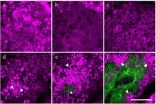(Press-News.org) Randomly distributed sticky spots which are integral to the development of stem cells by maximising adhesion and acting as internal scaffolding have been artificially recreated by experts from the University of Sheffield for the first time.
Using synthetic foam type materials to mimic the natural process – known as the extracellular matrix or ECM – scientists, from the University of Sheffield and University of California San Diego, created the random stickiness required for stem cells to properly adhere.
The findings will better inform researchers across the world of how to make their biomaterials appropriately sticky for stem cells to grow.
Previous attempts to recreate the process have managed only a uniform spread of sticky cells meaning there isn't the maximum hindering the stem cells maturation into tissue cells.
Professor Giuseppe Battaglia of the University's Department of Biomedical Science said: "We used two polymers, one that is sticky and one that is not, which separate from each other in solution. Just like with balsamic vinaigrette, we shook these two polymers up sufficiently to form randomly distributed nano-scopic patches of the sticky material – the balsamic vinegar –in a non-sticky material, just like the olive oil. To put it another way, these two materials phase separate within the foam to give you regions distinctly of one material or the other."
At the appropriate ratio of sticky and non-sticky polymer, the researchers found that it is possible to tune the size and distribution of the foam's adhesive regions: having less sticky polymer in the foam made its adhesive patches smaller and more dispersed, just like in the human body with natural ECM.
Professor Battaglia and Priyalakshmi Viswanathan, who performed most of the experimental work, added: "What was surprising to the team was that when we allowed stem cells to adhere to the foams, we found that random stickiness versus uniform stickiness was required for stem cells to properly adhere. We also found that this is likely necessary for stem cell development into mature tissue cells. In this sense, stem cells are like Goldilocks: the scaffold should not be too sticky or not sticky enough, it must be just right to maximize adhesion, and later, maturation into tissue cells."
###
The data was published following a collaboration between Professor of Synthetic Biology from Sheffield Giuseppe Battaglia, and Assistant Professor of Bioengineering from San Diego Adam Engler in the Journal of the American Chemical Society and was highlighted in this week's issue Nature.
The work was supported by grants from the National Institutes of Health and Human Frontiers Science Program
Stem cell 'sticky spots' recreated by scientists
2012-12-13
ELSE PRESS RELEASES FROM THIS DATE:
Study helps bridge gap in understanding of suicide risk for African-American women
2012-12-13
WASHINGTON, DC, December 13, 2012 — Three University of Kentucky (UK) sociologists have co-authored a study that helps to fill a gap in our understanding of suicide risk among African-American women.
Appearing in the December issue of Social Psychology Quarterly (SPQ), the study, "Too Much of a Good Thing? Psychosocial Resources, Gendered Racism, and Suicidal Ideation among Low Socioeconomic Status African American Women," examines the relationship between racial and gender discrimination and suicidal ideation, or thinking about and desiring to commit suicide. The co-authors ...
Head-mounted cameras could help robots understand social interactions
2012-12-13
PITTSBURGH—What is everyone looking at? It's a common question in social settings because the answer identifies something of interest, or helps delineate social groupings. Those insights someday will be essential for robots designed to interact with humans, so researchers at Carnegie Mellon University's Robotics Institute have developed a method for detecting where people's gazes intersect.
The researchers tested the method using groups of people with head-mounted video cameras. By noting where their gazes converged in three-dimensional space, the researchers could determine ...
Aerobic exercise boosts brain power
2012-12-13
Their review is published online in the Springer publication, Psychonomic Bulletin and Review.
A certain amount of mental deterioration is expected with advancing age. However, this may not necessarily have to be the case as particular aspects of cognitive function such as task switching, selective attention and working memory among others, all appear to benefit from aerobic exercise. Studies in older adults reviewed by the authors consistently found that fitter individuals scored better in mental tests than their unfit peers. In addition, intervention studies found scores ...
No more lying about your age: Scientists can now gauge skin’s true age with new laser technique
2012-12-13
Wrinkles, dryness, and a translucent and fragile appearance are hallmarks of old skin, caused by the natural aging of skin cells. But while most of us can recognize the signs of lost youth when we peer into the mirror each morning, scientists do not have a standardized way to measure the extent of age damage in skin. Now a group of Taiwanese researchers has used a specialized microscope to peer harmlessly beneath the skin surface to measure natural age-related changes in the sizes of skin cells. The results, which are published in the Optical Society's (OSA) open-access ...
12 matter particles suffice in nature
2012-12-13
This press release is available in German.
How many matter particles exist in nature? Particle physicists have been dealing with this question for a long time. The 12 matter particles contained in the standard model of particle physics? Or are there further particles with too high a mass to be produced by the experiments performed so far? These questions are now answered by researchers of KIT, CERN, and Humboldt University in the current issue of the Physical Review Letters. (DOI: 10.1103/PhysRevLett.109.241802)
Matter particles, also called fermions, are the elementary ...
Study sheds light on how cells transport materials along crowded intercellular 'highways'
2012-12-13
Worcester, Mass. – The interior of an animal cell is like a small city, with factories—called organelles—dedicated to manufacturing, energy production, waste processing, and other life functions. A network of intercellular "highways," called microtubules, enables bio-molecular complexes, products, and other cargo to move speedily about the cell to keep this vital machinery humming. A new paper published online in the journal Proceedings of the National Academy of Sciences sheds new light on how cells manage to keep traffic flowing smoothly along this busy transportation ...
Your Christmas tree and its genome have remained very much the same over the last 100 million years
2012-12-13
This press release is available in French.
Quebec City, December 13, 2012—A study published by Université Laval researchers and their colleagues from the Canadian Forest Service reveals that the genome of conifers such as spruce, pine, and fir has remained very much the same for over 100 million years. This remarkable genomic stability explains the resemblance between today's conifers and fossils dating back to the days when dinosaurs roamed the Earth. Details of this finding are presented in a recent issue of the journal BMC Biology.
The team supervised by Professor ...
OU study suggests the bacterial ecology that lives on humans has changed in the last 100 years
2012-12-13
A University of Oklahoma-led study has demonstrated that ancient DNA can be used to understand ancient human microbiomes. The microbiomes from ancient people have broad reaching implications for understanding recent changes to human health, such as what good bacteria might have been lost as a result of our current abundant use of antibiotics and aseptic practices.
Cecil M. Lewis Jr., professor of anthropology in the OU College of Arts and Sciences and director of the OU Molecular Anthropology Laboratory, and Raul Tito, OU Research Associate, led the research study that ...
Hospital-based neurologists worry about career burnout
2012-12-13
MAYWOOD, Il. - A survey has identified career burnout as a significant problem among neurologists who predominantly work with hospital inpatients.
Nearly 29 percent of these "neurohospitalists" said they had experienced burnout, and 45.8 percent said they were concerned about burnout but had not yet experienced it. (Burnout was defined as maintaining a schedule so burdensome as to limit the time a physician will or could spend as a neurohospitalist.)
Results were published in the December, 2012 issue of Neurology® Clinical Practice. Among the co-authors is Jose Biller, ...
Predicting risk of arrhythmias and sudden cardiac death: There's a computer model for that
2012-12-13
VIDEO:
Scientists are using "virtual hearts " to better understand risk in real-world patients. Researcher Coeli Lopes, Ph.D., University of Rochester Medical Center, assistant professor at the Aab Cardiovascular Research Institute, describes...
Click here for more information.
A computer model of the heart wall predicted risk of irregular heart rhythms and sudden cardiac death in patients, paving the way for the use of more complex cardiac models to calculate the ...


